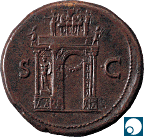

Everyone knows that Rome wasn't built in a day, that all roads lead there,
and that when there we are to do as the Romans do. Rome is of course the
city of seven hills as well as the eternal city but is also urbs et orbis,
"city and world." When Roma locuta est, "Rome has
spoken," the case is closed once and for all, and as the Roman poet
Ovid observes, Roma is Amor, "Love," spelled backwards.
Rome is therefore manifestly not just another city, for no other city is
the linguistic focal point for so many idiomatic expressions. Ancient Rome
is still more, however: a republic that provided the founding fathers of
the United States of America with a model par excellence of a mixed
constitution and the separation of powers, an empire that rose to unparalleled
heights and then slowly but surely fell, a civilization that dominates more
than a third of recorded western history, and a culture that endures today
in various forms, linguistic, literary, religious, political, and legal.
Rome's is therefore a history which must be reckoned with when essaying
to understand the historical development of just about any western cultural
artifact or institution, and coins are a striking (no pun intended) case
in point.
Despite its length, grandeur, and complexity Roman history lends itself
to ready and succinct summary. Legends tell us that Romulus founded the
city in 753 B.C. and that it was ruled by kings, some of them Etruscan,
until 509 B.C. when the republic was inaugurated. Rome grew by leaps and
bounds and by 265 B.C. had established itself as master of all Italy, and
then via a series of wars with Carthage and other overseas engagements it
assumed control of the Mediterranean lands and termed the sea mare nostrum,
"our sea." From 133 to 31 B.C. revolutions rocked the Roman world,
and when Caesar crossed the Rubicon, he altered the course of history forever.
His assassination on the Ides of March in 44 B.C. led ultimately to a monarchy
with his grand-nephew and adopted heir Octavian in charge, who as Augustus
ruled as the first Roman emperor until his death in A.D. 14.
The Julio-Claudian, Flavian, and Antonine dynasties gave Rome its most famous
emperors, who almost continuously expanded the empire's frontiers throughout
most of Europe, Asia Minor, and northern Africa, who were deified as a matter
of course, and who ruled their vast, prosperous, and relatively peaceful
(at least internally) empire with much acclaim until the end of the second
century A.D. From A.D. 193 until 284, however, emperor ousted emperor in
rapid succession; most were generals whose armies elevated them to imperial
power, and most died violent deaths. Late in the third century Diocletian
restored order and reformed the government, and after a brief but bloody
hiatus Constantine did likewise; under the latter, Christianity became the
de facto religion of the empire, but in A.D. 330 he also built another
Rome, New Rome, named Constantinople after himself, to which he removed
his imperial court. It was just a matter of time until Rome was to fall,
but it is a mark of its and the Church's eminence and power that the waves
of barbarian invaders were held off as long as they were. The city was sacked
in A.D. 410, and finally Romulus Augustulus, generally recognized as the
last Roman emperor even though only a child and a usurper, was deposed in
A.D. 476.
(Continues...)



The coin depicted above is No. 77
in the catalogue, sestertius of Nero, A.D. 64-66. Reverse: Triumphal arch.
All contents copyright (c) 1996.
Lawrence University
All rights reserved.